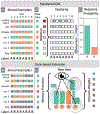"The eyes are the window to the representation": Linking gaze to memory precision and decision weights in object discrimination tasks
- PMID: 38753387
- PMCID: PMC12145153
- DOI: 10.1037/rev0000475
"The eyes are the window to the representation": Linking gaze to memory precision and decision weights in object discrimination tasks
Abstract
Humans selectively attend to task-relevant information in order to make accurate decisions. However, selective attention incurs consequences if the learning environment changes unexpectedly. This trade-off has been underscored by studies that compare learning behaviors between adults and young children: broad sampling during learning comes with a breadth of information in memory, often allowing children to notice details of the environment that are missed by their more selective adult counterparts. The current work extends the exemplar-similarity account of object discrimination to consider both the intentional and consequential aspects of selective attention when predicting choice. In a novel direct input approach, we used trial-level eye-tracking data from training and test to replace the otherwise freely estimated attention dynamics of the model. We demonstrate that only a model imbued with gaze correlates of memory precision in addition to decision weights can accurately predict key behaviors associated with (a) selective attention to a relevant dimension, (b) distributed attention across dimensions, and (c) flexibly shifting strategies between tasks. Although humans engage in selective attention with the intention of being accurate in the moment, our findings suggest that its consequences on memory constrain the information that is available for making decisions in the future. (PsycInfo Database Record (c) 2024 APA, all rights reserved).
Figures









Similar articles
-
The eye-mind wandering link: Identifying gaze indices of mind wandering across tasks.J Exp Psychol Hum Percept Perform. 2020 Oct;46(10):1201-1221. doi: 10.1037/xhp0000743. Epub 2020 Jul 30. J Exp Psychol Hum Percept Perform. 2020. PMID: 32730072
-
Gaze response to others' gaze following in children with and without autism.J Abnorm Psychol. 2020 Apr;129(3):320-329. doi: 10.1037/abn0000498. Epub 2020 Jan 9. J Abnorm Psychol. 2020. PMID: 31916783
-
Gaze Amplifies Value in Decision Making.Psychol Sci. 2019 Jan;30(1):116-128. doi: 10.1177/0956797618810521. Epub 2018 Dec 7. Psychol Sci. 2019. PMID: 30526339
-
As within, so without, as above, so below: Common mechanisms can support between- and within-trial category learning dynamics.Psychol Rev. 2022 Oct;129(5):1104-1143. doi: 10.1037/rev0000381. Epub 2022 Jul 18. Psychol Rev. 2022. PMID: 35849355 Free PMC article.
-
The relationship between gaze behavior, expertise, and performance: A systematic review.Psychol Bull. 2019 Oct;145(10):980-1027. doi: 10.1037/bul0000207. Epub 2019 Aug 15. Psychol Bull. 2019. PMID: 31414844
References
-
- Akaike H. (1974). A new look at the statistical model identification. IEEE Transactions on Automatic Control, 19(6), 716–723. 10.1109/TAC.1974.1100705 - DOI
-
- Ashby F, & Maddox W (1993). Relations between prototype, exemplar, and decision bound models of categorization. Journal of Mathematical Psychology, 37(3), 372–400. 10.1006/jmps.1993.1023 - DOI
MeSH terms
Grants and funding
LinkOut - more resources
Full Text Sources

